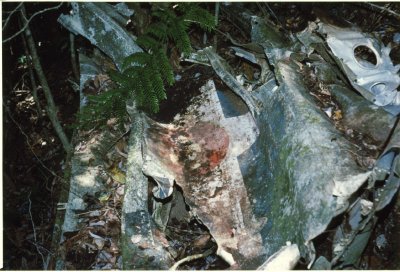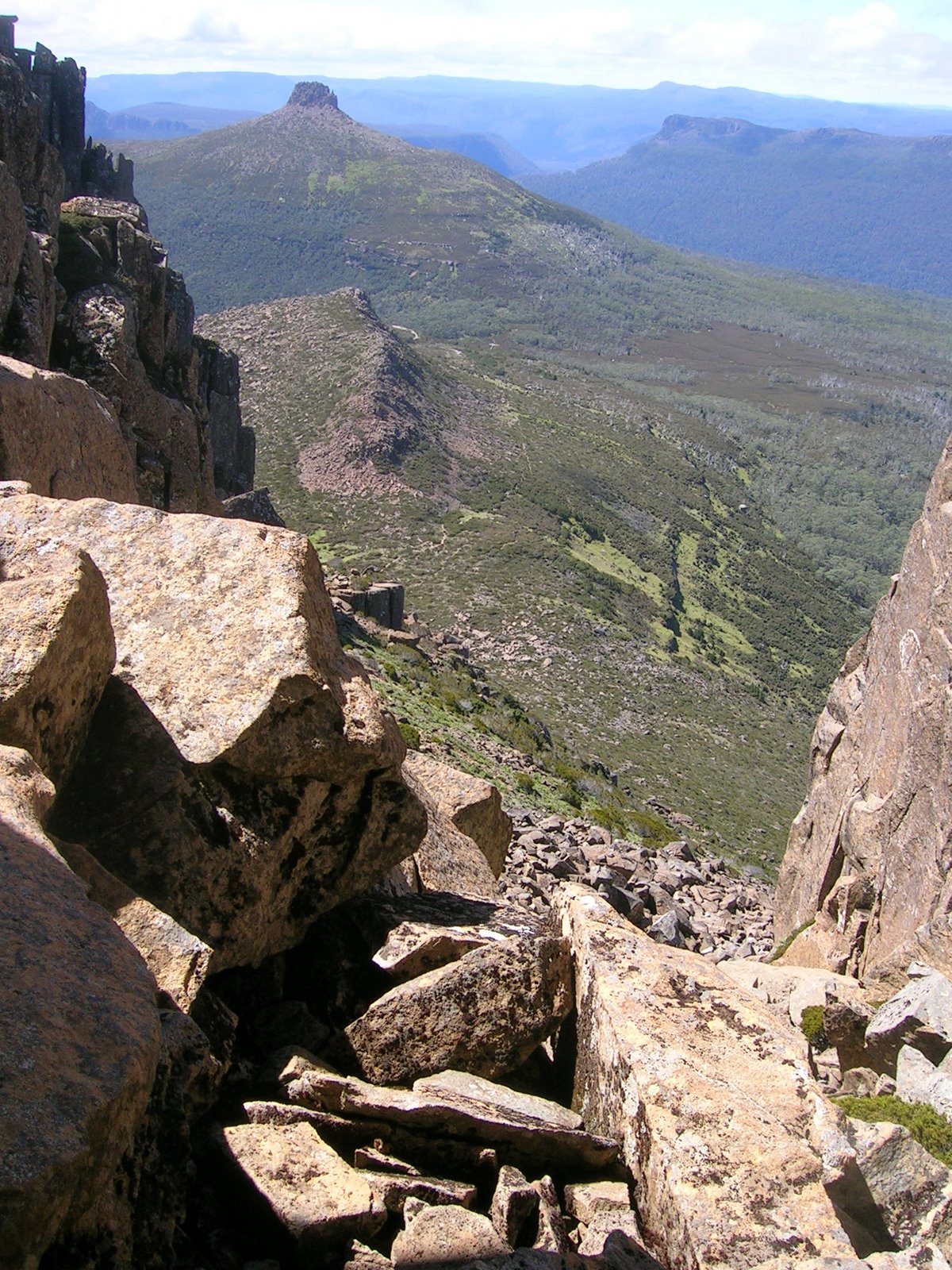|
Bellenden Ker Range
The Bellenden Ker Range, also known as the Wooroonooran Range is a coastal mountain range in Far North Queensland, Australia. Part of the Great Dividing Range it is located between Gordonvale and Babinda. The whole of the range falls within the Wet Tropics World Heritage Area and is covered in richly diverse world heritage listed wet tropical forests, including species of flora and fauna endemic to the range. The range also forms part of the Wooroonooran Important Bird Area, identified as such by BirdLife International because it supports populations of a range of bird species endemic to Queensland's Wet Tropics. Most of the range is also a gazetted protected area named Wooroonooran National Park. Queensland's two highest mountains, Mount Bartle Frere (1622 m) and Mount Bellenden Ker (1593 m) form part of this range, and Walshs Pyramid (922 m) (one of the highest free-standing natural pyramids in the world) is located at the range's northern end . History The mountains w ... [...More Info...] [...Related Items...] OR: [Wikipedia] [Google] [Baidu] |
Mount Bartle Frere
Mount Bartle Frere (pronunciation [ˈmæɔnt̥ ˈbɐːɾəɫ ˈfɹɪə]; Ngajanji: Choorechillum) is the highest mountain in Queensland at an elevation of . The mountain was named after Sir Henry Bartle Frere, 1st Baronet, Sir Henry Bartle Frere, a British colonial administrator and then president of the Royal Geographical Society by George Elphinstone Dalrymple in 1873. Bartle Frere was British Governor of Cape Colony at the outset of the Anglo-Zulu War. It is located south of Cairns, Queensland, Cairns in the Wooroonooran National Park southwest of the town of Babinda, Queensland, Babinda on the eastern edge of the Atherton Tablelands. Mount Bartle Frere is part of the Bellenden Ker Range and the watershed of Russell River (Queensland), Russell River. The foothill to summit is entirely covered by rainforest, ranging from typical tropical rainforest in the lowlands to low cloud forest at the cooler summit, where temperatures are up to 10 °C (18 °F) lower than on t ... [...More Info...] [...Related Items...] OR: [Wikipedia] [Google] [Baidu] |
Cairns Regional Council
The Cairns Region is a local government area in Far North Queensland, Queensland, Australia, centred on the regional city of Cairns. It was established in 2008 by the amalgamation of the City of Cairns and the Shires of Douglas and Mulgrave. However, following public protest and a referendum in 2013, on 1 January 2014, the Shire of Douglas was de-amalgamated from the Cairns Region and re-established as a separate local government authority. The Cairns Regional Council has an estimated operating budget of A$300 million. History First Nations '' Yidinji'' (also known as ''Yidinj'', ''Yidiny'', and ''Idindji'') is an Australian Aboriginal language and a traditional Indigenous country. Its traditional language region is within the local government areas of Cairns Region and Tablelands Region, in such localities as Cairns City (CBD), Gordonvale, and the Mulgrave River, and the southern part of the Atherton Tableland including Atherton and Kairi. '' Tjapukai'' (also known as ... [...More Info...] [...Related Items...] OR: [Wikipedia] [Google] [Baidu] |
List Of Mountains In Australia
This is a list of mountains in Australia. Highest points by state and territory List of mountains in Australia by topographic prominence This is a list of the top 50 mountains in Australia ranked by topographic prominence. Most of these peaks are the highest point in their areas. Australian Capital Territory The following is a list of mountains and prominent hills in the Australian Capital Territory in order, from the highest peak to the lowest peak, for those mountains and hills with an elevation above : New South Wales Queensland South Australia Tasmania Victoria Western Australia * Carnarvon Range * Mount Augustus (1105m) * Mount Beadell * Darling Range ** Mount Dale ** Mount Cooke * Hamersley Range ** Mount Meharry (at 1,249 metres above sea level, the highest peak in Western Australia) ** Mount Bruce (1,221 m; the second highest peak in WA) ** Mount Nameless/Jarndunmunha 1,115 m * Wunaamin Miliwundi Ranges, formerly King Leopold Ranges * ... [...More Info...] [...Related Items...] OR: [Wikipedia] [Google] [Baidu] |
Clamshell Falls
The Clamshell Falls is a cascade waterfall on the Behana Creek, located in Wooroonooran, Cairns Region, Queensland, Australia. Location and features The falls are situated in the Wooroonooran National Park Wooroonooran National Park (Aboriginal for "Black Rock") is a national park in Queensland, Australia, 1,367 km northwest of Brisbane, between Innisfail and Cairns. The park is one of the Wet Tropics World Heritage Area series of national p ... and descend down to the Behana Gorge, below the Whites Falls. See also * List of waterfalls of Queensland References Waterfalls of Far North Queensland Cascade waterfalls {{FarNorthQueensland-geo-stub ... [...More Info...] [...Related Items...] OR: [Wikipedia] [Google] [Baidu] |
Whites Falls
The Whites Falls, a waterfall on Behana Creek, is located in the UNESCO World Heritagelisted Wet Tropics in the Far North region of Queensland, Australia. The falls are situated above Clamshell Falls in the Wooroonooran National Park Wooroonooran National Park (Aboriginal for "Black Rock") is a national park in Queensland, Australia, 1,367 km northwest of Brisbane, between Innisfail and Cairns. The park is one of the Wet Tropics World Heritage Area series of national p .... See also * List of waterfalls of Queensland References Waterfalls of Far North Queensland {{FarNorthQueensland-geo-stub ... [...More Info...] [...Related Items...] OR: [Wikipedia] [Google] [Baidu] |
Silver Creek Falls
Silver is a chemical element with the symbol Ag (from the Latin ', derived from the Proto-Indo-European ''h₂erǵ'': "shiny" or "white") and atomic number 47. A soft, white, lustrous transition metal, it exhibits the highest electrical conductivity, thermal conductivity, and reflectivity of any metal. The metal is found in the Earth's crust in the pure, free elemental form ("native silver"), as an alloy with gold and other metals, and in minerals such as argentite and chlorargyrite. Most silver is produced as a byproduct of copper, gold, lead, and zinc refining. Silver has long been valued as a precious metal. Silver metal is used in many bullion coins, sometimes alongside gold: while it is more abundant than gold, it is much less abundant as a native metal. Its purity is typically measured on a per-mille basis; a 94%-pure alloy is described as "0.940 fine". As one of the seven metals of antiquity, silver has had an enduring role in most human cultures. Other than i ... [...More Info...] [...Related Items...] OR: [Wikipedia] [Google] [Baidu] |
Tchupala Falls
The Tchupala Falls, a segmented waterfall on the Henrietta Creek, is located in the UNESCO World Heritagelisted Wet Tropics in the Far North region of Queensland, Australia. Location and features The Tchupala Falls are situated in the Palmerston section of Wooroonooran National Park, descending from the Atherton Tableland, approximately west of Innisfail. A walking track is accessible via the Palmerston Highway The Palmerston Highway (State Route 25), serves as a link between the southern part of the Atherton Tablelands and the Far North Queensland coastal strip, in Australia. Starting just north of Innisfail, from the Bruce Highway it winds through ... and leads approximately from the trackhead to the Tchupala Falls. A further return track of approximately leads to Wallicher Falls, Silver Creek Falls and Nandroya Falls. Certain sections of the track may be closed for repairs including the steps down to the lower falls and the track east to Crawford's Lookout. See ... [...More Info...] [...Related Items...] OR: [Wikipedia] [Google] [Baidu] |
Josephine Falls
The Josephine Falls is a tiered cascade waterfall on the Josephine Creek located in Wooroonooran, Cairns Region in the Far North region of Queensland, Australia. Location and features The falls are situated at the foot of the southern face of Mount Bartle Frere in Wooroonooran National Park. They descend from the Atherton Tableland at an elevation of above sea level in the range of near a popular recreation site as the water flows over a large rock to form a natural waterslide on Josephine Creek, a tributary of the Russell River. Access to falls is via a sealed road off the Bruce Highway between Babinda Babinda is a rural town and locality in the Cairns Region, Queensland, Australia. In the , the locality of Babinda had a population of 1,253 people. Geography Babinda is located south of Cairns. The town is noted for its proximity to Queensla ... and Innisfail. The natural rock slide can be dangerous and the occasional flash flooding occurs without warning, with a sud ... [...More Info...] [...Related Items...] OR: [Wikipedia] [Google] [Baidu] |
Fishery Falls (Queensland)
Fishery Falls is a locality in the Cairns Region, Queensland, Australia. In the , Fishery Falls had a population of 141 people. Geography The Mulgrave River forms the eastern boundary of the locality; it flows into the Coral Sea in the neighbouring locality of Deeral. The land in the locality is flat (about 10 metres above sea level) and is predominantly freehold farming land with sugarcane the principal crop. The Bruce Highway passes through the locality from south to north-west with the North Coast railway line running immediately parallel and east of the highway, but there is no railway station within Fishery Falls. There is also a cane tramway network within the area to deliver the sugarcane to the Mulgrave Sugar Mill in Gordonvale. Although there is no official town, there is a hotel, a large caravan park, and a number of streets of houses clustered just west of the Bruce Highway at , although the school is located 2 km south of this township. History The loc ... [...More Info...] [...Related Items...] OR: [Wikipedia] [Google] [Baidu] |
Kearneys Falls
The Kearneys Falls is a Waterfall#Types, cascade waterfall on a tributary of the Mulgrave River, in the Wooroonooran National Park, in the Goldsborough Valley of Far North Queensland, Far North region of Queensland, Australia. Location and features Access to the falls is via a walking track. Camping facilities and the walking track to Kearneys Falls were closed in 2006 due to severe damage by both Tropical Cyclone Larry and Tropical Cyclone Monica. Camping facilities are available at the camp site and the track to the falls is open. History The falls were named after Frank Kearney, a grazier in the Mulgrave River area who died in 1918. See also * List of waterfalls of Australia#Queensland, List of waterfalls of Queensland References Waterfalls of Far North Queensland Cascade waterfalls {{FarNorthQueensland-geo-stub ... [...More Info...] [...Related Items...] OR: [Wikipedia] [Google] [Baidu] |



